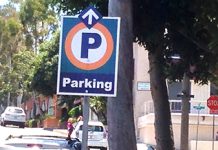Karen Klammer calculates that dedicated volunteers put in about 1,000 hours over the past 18 months to obtain the necessary support of 60 percent of Woods Cove property owners to establish an assessment district. Yard signs throughout the area spoke to their diligence in pursuit of undergrounding their utility poles.
Those hours paid off when the City Council voted 4-0 Tuesday, with Toni Iseman abstaining since she lives near the district, to move ahead with the project, with engineering and design costs of $600,000 initially underwritten by the city.
That phase will take about three years, estimated Steve May, the city’s public works director. Property owners will then cast a final ballot on whether to proceed. If they approve, the city will be reimbursed from the sale of municipal bonds issued to finance the project. But if property owners ultimately reject the project, the city will be out $600,000.
The Woods Cove undergrounding effort is the largest proposed in recent years and the second largest ever in the city, said City Manager John Pietig. It reveals the risks and slow pace of establishing assessment districts piecemeal as a method for undergrounding utilities and revived calls for a citywide solution to eradicating the unsafe and unsightly poles.
A few proposed districts in recent years did get voted down in the final ballot, said Pietig, who estimated that they cost the city about $180,000. Residents can end up rejecting the districts when confronted by unexpectedly high per-home assessments that fluctuate due to difficult terrain and construction costs.
“You’re not going to lose your money,” promised an impassioned Catherine Niemann. “We’re not going to give up…it’s the right thing to do for the community,” she said, pleading for Council support.
Putting the city’s utilities underfoot, thereby eliminating risks of fire-starting sparks from badly maintained wires, poles crashing down on homes, or live wires blocking egress routes, has become a hot issue over the past year.
“I believe it’s about time that we settle down and decide are we or are we not going to underground the city,” asked Arnold Hano, arguably the city’s leading advocate for citywide undergrounding.
He suggested Laguna Beach wrest the utility from Southern California Edison and become the owner of its own electricity grid. He said that while some might balk at what he described as the estimated $16 million cost of such a takeover, the estimated $6 million in annual profits to the city would soon recapture that expenditure. He noted that the city was prepared to spend $14 million “for a little walk in the village entrance,” referring to a park beautification plan for a parking lot near City Hall.
Cities across the country are increasingly exploring taking over the electricity from private utilities, largely to gain more control, a New York Times article reported last year. The city of Boulder, Colo., for example, approved such a plan earlier this year.
Mayor Pro Tem Bob Whalen shared Hano’s desire for a citywide solution, but instead endorsed creating a citywide taxing district for areas where above ground utilities remain. Such a measure would require support by two-thirds of voters and could be put on a future ballot. He said he supported the Woods Cove district, but insisted there are better ways to get the city undergrounded than the “contortionist kind of process” of assessment districts.
Six months ago, the city hired an engineering firm to assist districts in the making. They’ve been working with the Woods Cove property owners to adjust their district’s boundaries in order to achieve their 60 percent threshold, said May, who admitted it’s a complicated endeavor.
As a result, 15 properties where owners had signed petitions had to be eliminated from the project, according to the staff report. In the end, the district has 335 property owners, of whom 199 signed the petition and wrote a check for $500 to prove their commitment. By adding a parcel the city owns as a supporting property, they just made the numbers.
Another complication is the uncertainty of assessments, which can range from $10,000 to $40,000 for each property owner’s share, said May. Fees are apportioned based on benefits to the property in the form of improved views, safety, neighborhood aesthetics and general benefit to the public. While in the past views have been considered as the most significant factor, the safety component might carry greater weight in the Woods Cove area, said May. And since it includes parts of Glenneyre, which is heavily used as a through street, the general benefit to the public at large also factors in more prominently than other neighborhoods, and that benefit would be underwritten by the city and could be as much as $200,000 to $300,000, he said.
Despite the risk of owners balking at final assessment costs, Woods Cove advocate Larry Ulvestad told the Council that this was the “best district,” they were going in with their eyes open and they would not back down at the final ballot.
“I hope all you people stick with this,” said Council member Kelly Boyd, cautioning that it would take a long time to complete and noting “we will all have grayer hair when this is done.”
If public safety really is the council’s priority, “we’ve got to put our money where our mouth is, and really make this happen,” said Mayor Elizabeth Pearson.




